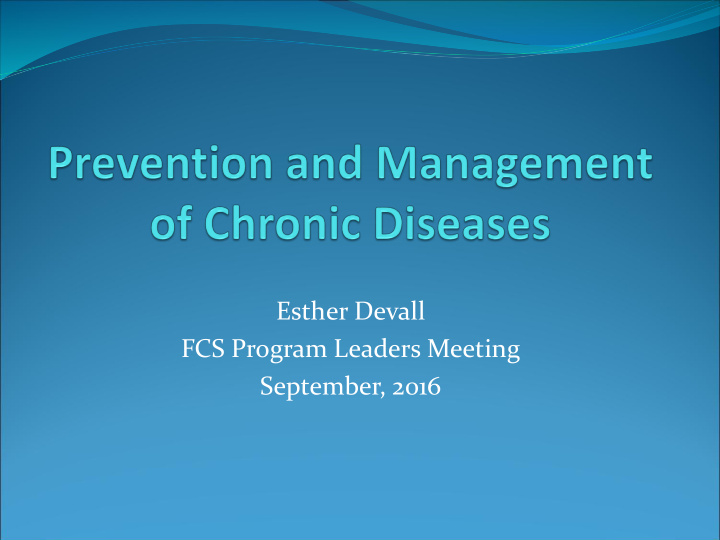



Esther Devall FCS Program Leaders Meeting September, 2016
Prevalence of Chronic Diseases Chronic conditions are among the most common, costly, and preventable of all health problems. 45% of all adults have a chronic health condition, and 25% have 2 or more. Leading cause of death and disability in the U.S. Risk factors for chronic diseases include poor nutrition, lack of physical activity, tobacco use, and overuse of alcohol. Treating people with chronic conditions accounts for 86% of our nation’s health care costs.
Characteristics of Chronic Conditions Long duration. Often incurable. Fluctuating course – ups and downs. Need for special treatments. May entail recurrent hospitalizations. May affect life expectancy. Requires assistance from many providers.
Nutrition Education SNAP-Ed and EFNEP help people eat healthier, spend food dollars wisely, and keep food safe. SNAP-Ed also focuses on policy, systems, and environmental change - improving school lunches, providing walking trails, addressing food deserts, etc. Programs are offered to adults and youth in every state in the western region.
Weight Management Colorado offers Healthy You – 6-week weight management and mindful eating program taught by a registered dietitian. Topics include portion control, planning ahead, eating on the go, fitting in exercise, realistic goals, and avoiding relapse. Self-paced printed version available in addition to weekly classes.
Diabetes Prevention National Diabetes Prevention Program (NDPP) – support group led by a lifestyle coach that meets weekly for 6 months and then monthly for 6 months. Focuses on eating healthy, increasing physical activity, and dealing with stress. Outcomes – weight loss; reduced risk of developing type 2 diabetes. New Mexico, Oregon, and Washington offer this program.
Physical Activity StrongWomen is a strength training program targeted to midlife and older women. It was developed by Dr. Miriam Nelson and colleagues from Tufts University. Classes meet for 1 hour twice a week for 12 weeks. Alaska, Colorado, and Montana are 3 of 8 states with ambassadors qualified to train the trainers. Alaska, Colorado, New Mexico, and Oregon offer this program.
Outcomes Increased muscle mass and strength. Reduced pain and stiffness. Increased range of motion. Better balance. Improved sleep.
Physical Activity StrongWomen – Healthy Hearts was also developed by Dr. Nelson. Focuses on aerobic activity and nutrition to prevent heart disease. Classes meet for 1 hour twice a week for 12 weeks. 30 minutes of each class is devoted to discussion of nutrition and hands-on cooking activities; 30 minutes devoted to dancing to a DVD or walking outside. Alaska, Montana, and Washington offer this program.
Outcomes Weight loss. Increased physical activity outside of class. Decreased waist Increase in self-efficacy circumference. for nutrition and Lower consumption of exercise. sweet foods and desserts.
Chronic Disease Self- Management Program • Developed by Stanford University. • Meets for 2.5 hours/week for 6 weeks. • Co-taught by 2 non-health professionals in a community setting. • Available in English and Spanish. • Alaska, Montana, and New Mexico offer this program. • Alaska and New Mexico have certified trainers.
Workshop Topics Techniques to deal with Appropriate use of fatigue, pain, isolation. medications. Exercises to improve Nutrition. strength, flexibility, and Decision-making. endurance. How to evaluate new Communicating with treatments. family, friends, and health providers.
Outcomes Improved symptom Fewer limitations in management. social and role activities. Better communication Fewer days in the with physicians. hospital. Less fatigue and pain. Decreased health care costs. Increased exercise. Return on investment 4:1
Diabetes Management Alaska and New Mexico offer Diabetes Self- Management Program . Montana offers Diabetes Empowerment Education Program (DEEP) – provides Medicare beneficiaries with 6 sessions on self-management of diabetes. Idaho offers Healthy Diabetes Plate – 4 lessons and a website that teach diabetes meal planning. Colorado offers Dining with Diabetes – 4 week program on healthy meal planning and food preparation.
Physical Activity Walk with Ease – classes meet for 1 hour for 18 sessions (3 times/week for 6 weeks or 2 times/week for 9 weeks); led by a trained, CPR-certified leader. In-person classes or self-guided program available in both English and Spanish. Goal is to help people with arthritis or other chronic diseases learn how to exercise safely and comfortably. Outcomes – increased balance, strength, and walking pace; improved overall health. Oregon offers this program.
Physical Activity Better Bones and Balance – balance and strength training program for older individuals to reduce risk of osteoporosis and falling. Beginning, intermediate, and advanced levels. Wear weighted vests while exercising to strengthen hip bones. In person classes and DVD option available. Oregon State offers this program.
Mental Health Mental Health First Aid Training – 8-hour course that teaches how to assist someone having a mental health or substance use crisis. Developed in Australia, now taught in 18 countries. Outcomes – increased knowledge of mental illness; greater awareness of professional and self-help resources; increased likelihood of helping someone in distress. Montana will have Master Trainers to begin offering this program soon.
Mental Health Youth Aware of Mental Health (YAM) was developed in Europe. 5 sessions delivered over 4-weeks, with discussions about mental health and role plays about stress and crisis situations. Outcomes – decreased depression and anxiety; reduced suicide ideation, plans, and attempts. Montana (and Texas) were the first to pilot this program in the U.S. Next, extension agents will be trained to offer the program.
Recommend
More recommend